风险投资学课后思考题答案
- 格式:wps
- 大小:145.99 KB
- 文档页数:18
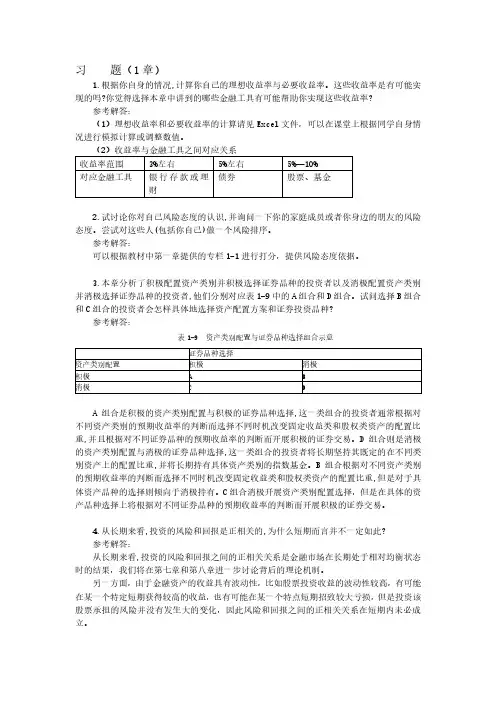
习题(1章)1.根据你自身的情况,计算你自己的理想收益率与必要收益率。
这些收益率是有可能实现的吗?你觉得选择本章中讲到的哪些金融工具有可能帮助你实现这些收益率?参考解答:(1)理想收益率和必要收益率的计算请见Excel文件,可以在课堂上根据同学自身情况进行模拟计算或调整数值。
2.试讨论你对自己风险态度的认识,并询问一下你的家庭成员或者你身边的朋友的风险态度。
尝试对这些人(包括你自己)做一个风险排序。
参考解答:可以根据教材中第一章提供的专栏1-1进行打分,提供风险态度依据。
3.本章分析了积极配置资产类别并积极选择证券品种的投资者以及消极配置资产类别并消极选择证券品种的投资者,他们分别对应表1-9中的A组合和D组合。
试问选择B组合和C组合的投资者会怎样具体地选择资产配置方案和证券投资品种?参考解答:表1-9 资产类别配置与证券品种选择组合示意A组合是积极的资产类别配置与积极的证券品种选择,这一类组合的投资者通常根据对不同资产类别的预期收益率的判断而选择不同时机改变固定收益类和股权类资产的配置比重,并且根据对不同证券品种的预期收益率的判断而开展积极的证券交易。
D组合则是消极的资产类别配置与消极的证券品种选择,这一类组合的投资者将长期坚持其既定的在不同类别资产上的配置比重,并将长期持有具体资产类别的指数基金。
B组合根据对不同资产类别的预期收益率的判断而选择不同时机改变固定收益类和股权类资产的配置比重,但是对于具体资产品种的选择则倾向于消极持有。
C组合消极开展资产类别配置选择,但是在具体的资产品种选择上将根据对不同证券品种的预期收益率的判断而开展积极的证券交易。
4.从长期来看,投资的风险和回报是正相关的,为什么短期而言并不一定如此?参考解答:从长期来看,投资的风险和回报之间的正相关关系是金融市场在长期处于相对均衡状态时的结果,我们将在第七章和第八章进一步讨论背后的理论机制。
另一方面,由于金融资产的收益具有波动性,比如股票投资收益的波动性较高,有可能在某一个特定短期获得较高的收益,也有可能在某一个特点短期招致较大亏损,但是投资该股票承担的风险并没有发生大的变化,因此风险和回报之间的正相关关系在短期内未必成立。
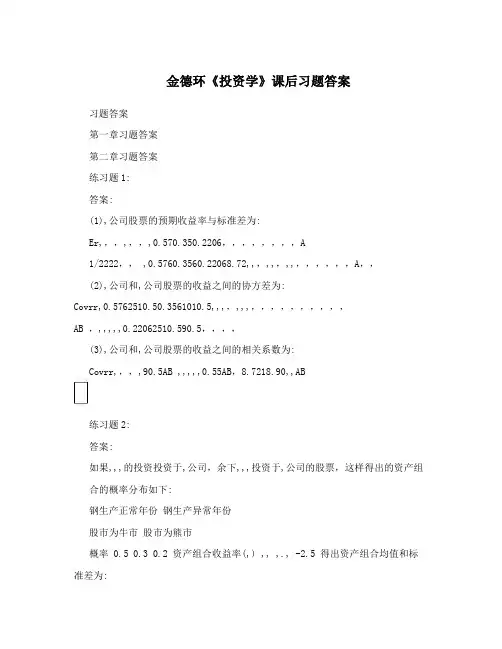
金德环《投资学》课后习题答案习题答案第一章习题答案第二章习题答案练习题1:答案:(1),公司股票的预期收益率与标准差为:Er,,,,,,,0.570.350.2206,,,,,,,,A1/2222,, ,0.5760.3560.22068.72,,,,,,,,,,,,,,A,,(2),公司和,公司股票的收益之间的协方差为:Covrr,0.5762510.50.3561010.5,,,,,,,,,,,,,,,,,AB ,,,,,,0.22062510.590.5,,,,(3),公司和,公司股票的收益之间的相关系数为:Covrr,,,,90.5AB ,,,,,0.55AB,8.7218.90,,AB练习题2:答案:如果,,,的投资投资于,公司,余下,,,投资于,公司的股票,这样得出的资产组合的概率分布如下:钢生产正常年份钢生产异常年份股市为牛市股市为熊市概率 0.5 0.3 0.2 资产组合收益率(,) ,, ,., -2.5 得出资产组合均值和标准差为:Er=0.516+0.32.5+0.2-2.5=8.25,,,,,,,,,,组合1/22222,, ,=0.516-8.25+0.32.5-8.25+0.2-2.5-8.25+0.2-2.5-8.25=7.94,,,,,,,,组合,,1/22222,=0.518.9+0.58.72+20.50.5-90.5=7.94,,,,,,,,,,,,,,,组合,,练习题3:答案:尽管黄金投资独立看来似有股市控制,黄金仍然可以在一个分散化的资产组合中起作用。
因为黄金与股市收益的相关性很小,股票投资者可以通过将其部分资金投资于黄金来分散其资产组合的风险。
练习题4:答案:通过计算两个项目的变异系数来进行比较:0.075 CV==1.88A0.040.09 CV==0.9B0.1考虑到相对离散程度,投资项目B更有利。
练习题5:答案:R(1)回归方程解释能力到底如何的一种测度方法式看的总方差中可被方程解释的方差所it2,占的比例。
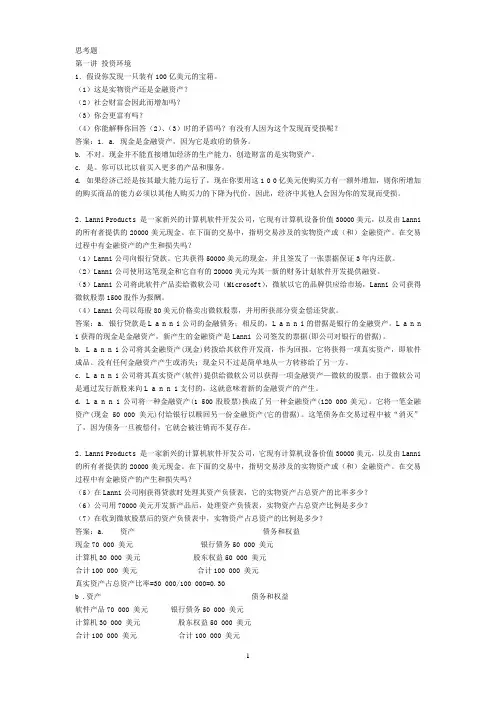
思考题第一讲投资环境1.假设你发现一只装有100亿美元的宝箱。
(1)这是实物资产还是金融资产?(2)社会财富会因此而增加吗?(3)你会更富有吗?(4)你能解释你回答(2)、(3)时的矛盾吗?有没有人因为这个发现而受损呢?答案:1. a. 现金是金融资产,因为它是政府的债务。
b. 不对。
现金并不能直接增加经济的生产能力,创造财富的是实物资产。
c. 是。
你可以比以前买入更多的产品和服务。
d. 如果经济已经是按其最大能力运行了,现在你要用这1 0 0亿美元使购买力有一额外增加,则你所增加的购买商品的能力必须以其他人购买力的下降为代价,因此,经济中其他人会因为你的发现而受损。
2.Lanni Products 是一家新兴的计算机软件开发公司,它现有计算机设备价值30000美元,以及由Lanni 的所有者提供的20000美元现金。
在下面的交易中,指明交易涉及的实物资产或(和)金融资产。
在交易过程中有金融资产的产生和损失吗?(1)Lanni公司向银行贷款。
它共获得50000美元的现金,并且签发了一张票据保证3年内还款。
(2)Lanni公司使用这笔现金和它自有的20000美元为其一新的财务计划软件开发提供融资。
(3)Lanni公司将此软件产品卖给微软公司(Microsoft),微软以它的品牌供应给市场,Lanni公司获得微软股票1500股作为报酬。
(4)Lanni公司以每股80美元价格卖出微软股票,并用所获部分资金偿还贷款。
答案:a. 银行贷款是L a n n i公司的金融债务;相反的,L a n n i的借据是银行的金融资产。
L a n n i获得的现金是金融资产,新产生的金融资产是Lanni 公司签发的票据(即公司对银行的借据)。
b. L a n n i公司将其金融资产(现金)转拨给其软件开发商,作为回报,它将获得一项真实资产,即软件成品。
没有任何金融资产产生或消失;现金只不过是简单地从一方转移给了另一方。
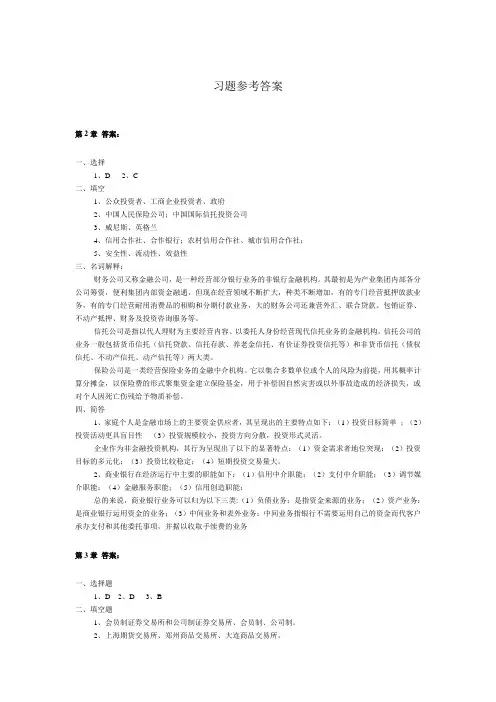
习题参考答案第2章答案:一、选择1、D2、C二、填空1、公众投资者、工商企业投资者、政府2、中国人民保险公司;中国国际信托投资公司3、威尼斯、英格兰4、信用合作社、合作银行;农村信用合作社、城市信用合作社;5、安全性、流动性、效益性三、名词解释:财务公司又称金融公司,是一种经营部分银行业务的非银行金融机构。
其最初是为产业集团内部各分公司筹资,便利集团内部资金融通,但现在经营领域不断扩大,种类不断增加,有的专门经营抵押放款业务,有的专门经营耐用消费品的租购和分期付款业务,大的财务公司还兼营外汇、联合贷款、包销证券、不动产抵押、财务及投资咨询服务等。
信托公司是指以代人理财为主要经营内容、以委托人身份经营现代信托业务的金融机构。
信托公司的业务一般包括货币信托(信托贷款、信托存款、养老金信托、有价证券投资信托等)和非货币信托(债权信托、不动产信托、动产信托等)两大类。
保险公司是一类经营保险业务的金融中介机构。
它以集合多数单位或个人的风险为前提,用其概率计算分摊金,以保险费的形式聚集资金建立保险基金,用于补偿因自然灾害或以外事故造成的经济损失,或对个人因死亡伤残给予物质补偿。
四、简答1、家庭个人是金融市场上的主要资金供应者,其呈现出的主要特点如下:(1)投资目标简单;(2)投资活动更具盲目性(3)投资规模较小,投资方向分散,投资形式灵活。
企业作为非金融投资机构,其行为呈现出了以下的显著特点:(1)资金需求者地位突现;(2)投资目标的多元化;(3)投资比较稳定;(4)短期投资交易量大。
2、商业银行在经济运行中主要的职能如下:(1)信用中介职能;(2)支付中介职能;(3)调节媒介职能;(4)金融服务职能;(5)信用创造职能;总的来说,商业银行业务可以归为以下三类:(1)负债业务:是指资金来源的业务;(2)资产业务:是商业银行运用资金的业务;(3)中间业务和表外业务:中间业务指银行不需要运用自己的资金而代客户承办支付和其他委托事项,并据以收取手续费的业务第3章答案:一、选择题1、D2、D3、B二、填空题1、会员制证券交易所和公司制证券交易所、会员制、公司制。
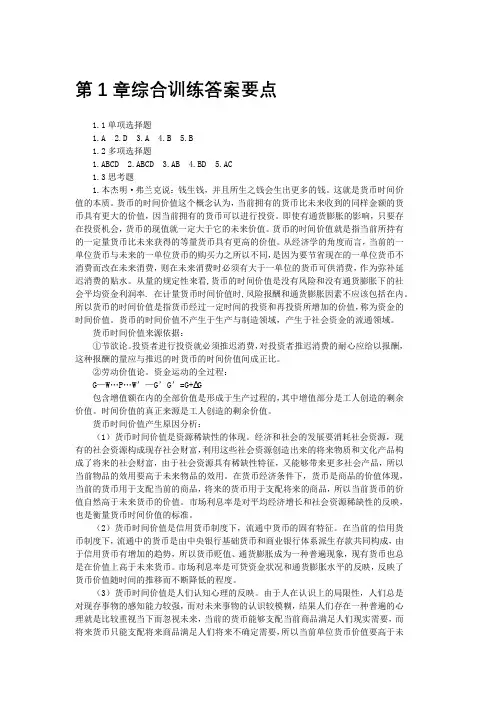
第1章综合训练答案要点1.1单项选择题1.A2.D3.A4.B5.B1.2多项选择题1.ABCD2.ABCD3.AB4.BD5.AC1.3思考题1.本杰明·弗兰克说:钱生钱,并且所生之钱会生出更多的钱。
这就是货币时间价值的本质。
货币的时间价值这个概念认为,当前拥有的货币比未来收到的同样金额的货币具有更大的价值,因当前拥有的货币可以进行投资。
即使有通货膨胀的影响,只要存在投资机会,货币的现值就一定大于它的未来价值。
货币的时间价值就是指当前所持有的一定量货币比未来获得的等量货币具有更高的价值。
从经济学的角度而言,当前的一单位货币与未来的一单位货币的购买力之所以不同,是因为要节省现在的一单位货币不消费而改在未来消费,则在未来消费时必须有大于一单位的货币可供消费,作为弥补延迟消费的贴水。
从量的规定性来看,货币的时间价值是没有风险和没有通货膨胀下的社会平均资金利润率. 在计量货币时间价值时,风险报酬和通货膨胀因素不应该包括在内。
所以货币的时间价值是指货币经过一定时间的投资和再投资所增加的价值,称为资金的时间价值。
货币的时间价值不产生于生产与制造领域,产生于社会资金的流通领域。
货币时间价值来源依据:①节欲论。
投资者进行投资就必须推迟消费,对投资者推迟消费的耐心应给以报酬,这种报酬的量应与推迟的时货币的时间价值间成正比。
②劳动价值论。
资金运动的全过程:G—W…P…W’—G’G’=G+∆G包含增值额在内的全部价值是形成于生产过程的,其中增值部分是工人创造的剩余价值。
时间价值的真正来源是工人创造的剩余价值。
货币时间价值产生原因分析:(1)货币时间价值是资源稀缺性的体现。
经济和社会的发展要消耗社会资源,现有的社会资源构成现存社会财富,利用这些社会资源创造出来的将来物质和文化产品构成了将来的社会财富,由于社会资源具有稀缺性特征,又能够带来更多社会产品,所以当前物品的效用要高于未来物品的效用。
在货币经济条件下,货币是商品的价值体现,当前的货币用于支配当前的商品,将来的货币用于支配将来的商品,所以当前货币的价值自然高于未来货币的价值。
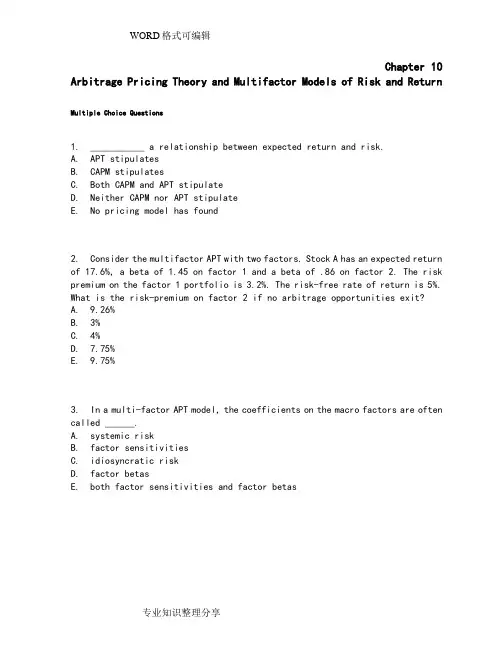
Chapter 10 Arbitrage Pricing Theory and Multifactor Models of Risk and ReturnMultiple Choice Questions1. ___________ a relationship between expected return and risk.A. APT stipulatesB. CAPM stipulatesC. Both CAPM and APT stipulateD. Neither CAPM nor APT stipulateE. No pricing model has found2. Consider the multifactor APT with two factors. Stock A has an expected return of 17.6%, a beta of 1.45 on factor 1 and a beta of .86 on factor 2. The risk premium on the factor 1 portfolio is3.2%. The risk-free rate of return is 5%. What is the risk-premium on factor 2 if no arbitrage opportunities exit?A. 9.26%B. 3%C. 4%D. 7.75%E. 9.75%3. In a multi-factor APT model, the coefficients on the macro factors are often called ______.A. systemic riskB. factor sensitivitiesC. idiosyncratic riskD. factor betasE. both factor sensitivities and factor betas4. In a multi-factor APT model, the coefficients on the macro factors are often called ______.A. systemic riskB. firm-specific riskC. idiosyncratic riskD. factor betasE. unique risk5. In a multi-factor APT model, the coefficients on the macro factors are often called ______.A. systemic riskB. firm-specific riskC. idiosyncratic riskD. factor loadingsE. unique risk6. Which pricing model provides no guidance concerning the determination of the risk premium on factor portfolios?A. The CAPMB. The multifactor APTC. Both the CAPM and the multifactor APTD. Neither the CAPM nor the multifactor APTE. No pricing model currently exists that provides guidance concerning the determination of the risk premium on any portfolio7. An arbitrage opportunity exists if an investor can construct a __________ investment portfolio that will yield a sure profit.A. small positiveB. small negativeC. zeroD. large positiveE. large negative8. The APT was developed in 1976 by ____________.A. LintnerB. Modigliani and MillerC. RossD. SharpeE. Fama9. A _________ portfolio is a well-diversified portfolio constructed to havea beta of 1 on one of the factors and a beta of 0 on any other factor.A. factorB. marketC. indexD. factor and marketE. factor, market, and index10. The exploitation of security mispricing in such a way that risk-free economic profits may be earned is called ___________.A. arbitrageB. capital asset pricingC. factoringD. fundamental analysisE. technical analysis11. In developing the APT, Ross assumed that uncertainty in asset returns wasa result ofA. a common macroeconomic factor.B. firm-specific factors.C. pricing error.D. neither common macroeconomic factors nor firm-specific factors.E. both common macroeconomic factors and firm-specific factors.12. The ____________ provides an unequivocal statement on the expected return-beta relationship for all assets, whereas the _____________ implies that this relationship holds for all but perhaps a small number of securities.A. APT; CAPMB. APT; OPMC. CAPM; APTD. CAPM; OPME. APT and OPM; CAPM13. Consider a single factor APT. Portfolio A has a beta of 1.0 and an expected return of 16%. Portfolio B has a beta of 0.8 and an expected return of 12%. The risk-free rate of return is 6%. If you wanted to take advantage of an arbitrage opportunity, you should take a short position in portfolio __________ and a long position in portfolio _______.A. A; AB. A; BC. B; AD. B; BE. A; the riskless asset14. Consider the single factor APT. Portfolio A has a beta of 0.2 and an expected return of 13%. Portfolio B has a beta of 0.4 and an expected return of 15%. The risk-free rate of return is 10%. If you wanted to take advantage of an arbitrage opportunity, you should take a short position in portfolio _________ and a long position in portfolio _________.A. A; AB. A; BC. B; AD. B; BE. No arbitrage opportunity exists.15. Consider the one-factor APT. The variance of returns on the factor portfolio is 6%. The beta of a well-diversified portfolio on the factor is 1.1. The variance of returns on the well-diversified portfolio is approximately __________.A. 3.6%B. 6.0%C. 7.3%D. 10.1%E. 8.6%16. Consider the one-factor APT. The standard deviation of returns on a well-diversified portfolio is 18%. The standard deviation on the factor portfolio is 16%. The beta of the well-diversified portfolio is approximately __________.A. 0.80B. 1.13C. 1.25D. 1.56E. 0.9317. Consider the single-factor APT. Stocks A and B have expected returns of 15% and 18%, respectively. The risk-free rate of return is 6%. Stock B has a beta of 1.0. If arbitrage opportunities are ruled out, stock A has a beta of __________.A. 0.67B. 1.00C. 1.30D. 1.69E. 0.7518. Consider the multifactor APT with two factors. Stock A has an expected return of 16.4%, a beta of 1.4 on factor 1 and a beta of .8 on factor 2. The risk premium on the factor 1 portfolio is 3%. The risk-free rate of return is 6%. What is the risk-premium on factor 2 if no arbitrage opportunities exit?A. 2%B. 3%C. 4%D. 7.75%E. 6.89%19. Consider the multifactor model APT with two factors. Portfolio A has a beta of 0.75 on factor 1 and a beta of 1.25 on factor 2. The risk premiums on the factor 1 and factor 2 portfolios are 1% and 7%, respectively. The risk-free rate of return is 7%. The expected return on portfolio A is __________ if no arbitrage opportunities exist.A. 13.5%B. 15.0%C. 16.5%D. 23.0%E. 18.7%20. Consider the multifactor APT with two factors. The risk premiums on the factor 1 and factor 2 portfolios are 5% and 6%, respectively. Stock A has a beta of 1.2 on factor 1, and a beta of 0.7 on factor 2. The expected return on stock A is 17%. If no arbitrage opportunities exist, the risk-free rate of return is ___________.A. 6.0%B. 6.5%C. 6.8%D. 7.4%E. 7.7%21. Consider a one-factor economy. Portfolio A has a beta of 1.0 on the factor and portfolio B has a beta of 2.0 on the factor. The expected returns on portfolios A and B are 11% and 17%, respectively. Assume that the risk-free rate is 6% and that arbitrage opportunities exist. Suppose you invested $100,000 in the risk-free asset, $100,000 in portfolio B, and sold short $200,000 of portfolio A. Your expected profit from this strategy would be ______________.A. −$1,000B. $0C. $1,000D. $2,000E. $1,60022. Consider the one-factor APT. Assume that two portfolios, A and B, are well diversified. The betas of portfolios A and B are 1.0 and 1.5, respectively. The expected returns on portfolios A and B are 19% and 24%, respectively. Assuming no arbitrage opportunities exist, the risk-free rate of return must be____________.A. 4.0%B. 9.0%C. 14.0%D. 16.5%E. 8.2%23. Consider the multifactor APT. The risk premiums on the factor 1 and factor 2 portfolios are 5% and 3%, respectively. The risk-free rate of return is 10%. Stock A has an expected return of 19% and a beta on factor 1 of 0.8. Stock A has a beta on factor 2 of ________.A. 1.33B. 1.50C. 1.67D. 2.00E. 1.7324. Consider the single factor APT. Portfolios A and B have expected returns of 14% and 18%, respectively. The risk-free rate of return is 7%. Portfolio A has a beta of 0.7. If arbitrage opportunities are ruled out, portfolio B must have a beta of __________.A. 0.45B. 1.00C. 1.10D. 1.22E. 1.33There are three stocks, A, B, and C. You can either invest in these stocks or short sell them. There are three possible states of nature for economic growth in the upcoming year; economic growth may be strong, moderate, or weak. The returns for the upcoming year on stocks A, B, and C for each of these states of nature are given below:25. If you invested in an equally weighted portfolio of stocks A and B, your portfolio return would be ___________ if economic growth were moderate.A. 3.0%B. 14.5%C. 15.5%D. 16.0%E. 17.0%26. If you invested in an equally weighted portfolio of stocks A and C, your portfolio return would be ____________ if economic growth was strong.A. 17.0%B. 22.5%C. 30.0%D. 30.5%E. 25.6%27. If you invested in an equally weighted portfolio of stocks B and C, your portfolio return would be _____________ if economic growth was weak.A. −2.5%B. 0.5%C. 3.0%D. 11.0%E. 9.0%28. If you wanted to take advantage of a risk-free arbitrage opportunity, you should take a short position in _________ and a long position in an equally weighted portfolio of _______.A. A; B and CB. B; A and CC. C; A and BD. A and B; CE. No arbitrage opportunity exists.Consider the multifactor APT. There are two independent economic factors, Fand1. The risk-free rate of return is 6%. The following information is available F2about two well-diversified portfolios:29. Assuming no arbitrage opportunities exist, the risk premium on the factor Fportfolio should be __________.1A. 3%B. 4%C. 5%D. 6%E. 2%30. Assuming no arbitrage opportunities exist, the risk premium on the factor Fportfolio should be ___________.2A. 3%B. 4%C. 5%D. 6%E. 2%31. A zero-investment portfolio with a positive expected return arises when _________.A. an investor has downside risk onlyB. the law of prices is not violatedC. the opportunity set is not tangent to the capital allocation lineD. a risk-free arbitrage opportunity existsE. a risk-free arbitrage opportunity does not exist32. An investor will take as large a position as possible when an equilibrium price relationship is violated. This is an example of _________.A. a dominance argumentB. the mean-variance efficiency frontierC. a risk-free arbitrageD. the capital asset pricing modelE. the SML33. The APT differs from the CAPM because the APT _________.A. places more emphasis on market riskB. minimizes the importance of diversificationC. recognizes multiple unsystematic risk factorsD. recognizes multiple systematic risk factorsE. places more emphasis on systematic risk34. The feature of the APT that offers the greatest potential advantage over the CAPM is the ______________.A. use of several factors instead of a single market index to explain the risk-return relationshipB. identification of anticipated changes in production, inflation, and term structure as key factors in explaining the risk-return relationshipC. superior measurement of the risk-free rate of return over historical time periodsD. variability of coefficients of sensitivity to the APT factors for a given asset over timeE. superior measurement of the risk-free rate of return over historical time periods and variability of coefficients of sensitivity to the APT factors for a given asset over time35. In terms of the risk/return relationship in the APTA. only factor risk commands a risk premium in market equilibrium.B. only systematic risk is related to expected returns.C. only nonsystematic risk is related to expected returns.D. only factor risk commands a risk premium in market equilibrium and only systematic risk is related to expected returns.E. only factor risk commands a risk premium in market equilibrium and only nonsystematic risk is related to expected returns.36. The following factors might affect stock returns:A. the business cycle.B. interest rate fluctuations.C. inflation rates.D. the business cycle, interest rate fluctuations, and inflation rates.E. the relationship between past FRED spreads.37. Advantage(s) of the APT is(are)A. that the model provides specific guidance concerning the determination of the risk premiums on the factor portfolios.B. that the model does not require a specific benchmark market portfolio.C. that risk need not be considered.D. that the model provides specific guidance concerning the determination of the risk premiums on the factor portfolios and that the model does not require a specific benchmark market portfolio.E. that the model does not require a specific benchmark market portfolio and that risk need not be considered.38. Portfolio A has expected return of 10% and standard deviation of 19%. Portfolio B has expected return of 12% and standard deviation of 17%. Rational investors willA. borrow at the risk free rate and buy A.B. sell A short and buy B.C. sell B short and buy A.D. borrow at the risk free rate and buy B.E. lend at the risk free rate and buy B.39. An important difference between CAPM and APT isA. CAPM depends on risk-return dominance; APT depends on a no arbitrage condition.B. CAPM assumes many small changes are required to bring the market back to equilibrium; APT assumes a few large changes are required to bring the market back to equilibrium.C. implications for prices derived from CAPM arguments are stronger than prices derived from APT arguments.D. CAPM depends on risk-return dominance; APT depends on a no arbitrage condition, CAPM assumes many small changes are required to bring the market back to equilibrium; APT assumes a few large changes are required to bring the market back to equilibrium, implications for prices derived from CAPM arguments are stronger than prices derived from APT arguments.E. CAPM depends on risk-return dominance; APT depends on a no arbitrage condition and assumes many small changes are required to bring the market back to equilibrium.40. A professional who searches for mispriced securities in specific areas such as merger-target stocks, rather than one who seeks strict (risk-free) arbitrage opportunities is engaged inA. pure arbitrage.B. risk arbitrage.C. option arbitrage.D. equilibrium arbitrage.E. covered interest arbitrage.41. In the context of the Arbitrage Pricing Theory, as a well-diversified portfolio becomes larger its nonsystematic risk approachesA. one.B. infinity.C. zero.D. negative one.E. None of these is correct.42. A well-diversified portfolio is defined asA. one that is diversified over a large enough number of securities that the nonsystematic variance is essentially zero.B. one that contains securities from at least three different industry sectors.C. a portfolio whose factor beta equals 1.0.D. a portfolio that is equally weighted.E. a portfolio that is equally weighted and contains securities from at least three different industry sectors.43. The APT requires a benchmark portfolioA. that is equal to the true market portfolio.B. that contains all securities in proportion to their market values.C. that need not be well-diversified.D. that is well-diversified and lies on the SML.E. that is unobservable.44. Imposing the no-arbitrage condition on a single-factor security market implies which of the following statements?I) the expected return-beta relationship is maintained for all but a small number of well-diversified portfolios.II) the expected return-beta relationship is maintained for all well-diversified portfolios.III) the expected return-beta relationship is maintained for all but a small number of individual securities.IV) the expected return-beta relationship is maintained for all individual securities.A. I and III are correct.B. I and IV are correct.C. II and III are correct.D. II and IV are correct.E. Only I is correct.45. Consider a well-diversified portfolio, A, in a two-factor economy. The risk-free rate is 6%, the risk premium on the first factor portfolio is 4% and the risk premium on the second factor portfolio is 3%. If portfolio A has a beta of 1.2 on the first factor and .8 on the second factor, what is its expected return?A. 7.0%B. 8.0%C. 9.2%D. 13.0%E. 13.2%46. The term "arbitrage" refers toA. buying low and selling high.B. short selling high and buying low.C. earning risk-free economic profits.D. negotiating for favorable brokerage fees.E. hedging your portfolio through the use of options.47. To take advantage of an arbitrage opportunity, an investor wouldI) construct a zero investment portfolio that will yield a sure profit.II) construct a zero beta investment portfolio that will yield a sure profit. III) make simultaneous trades in two markets without any net investment. IV) short sell the asset in the low-priced market and buy it in the high-priced market.A. I and IVB. I and IIIC. II and IIID. I, III, and IVE. II, III, and IV48. The factor F in the APT model representsA. firm-specific risk.B. the sensitivity of the firm to that factor.C. a factor that affects all security returns.D. the deviation from its expected value of a factor that affects all security returns.E. a random amount of return attributable to firm events.49. In the APT model, what is the nonsystematic standard deviation of an equally-weighted portfolio that has an average value of σ(e) equal to 25% andi50 securities?A. 12.5%B. 625%C. 0.5%D. 3.54%E. 14.59%50. In the APT model, what is the nonsystematic standard deviation of an equally-weighted portfolio that has an average value of σ(e) equal to 20% andi20 securities?A. 12.5%B. 625%C. 4.47%D. 3.54%E. 14.59%51. In the APT model, what is the nonsystematic standard deviation of an) equal to 20% and equally-weighted portfolio that has an average value of σ(ei40 securities?A. 12.5%B. 625%C. 0.5%D. 3.54%E. 3.16%52. In the APT model, what is the nonsystematic standard deviation of an) equal to 18% and equally-weighted portfolio that has an average value of (ei250 securities?A. 1.14%B. 625%C. 0.5%D. 3.54%E. 3.16%53. Which of the following is true about the security market line (SML) derived from the APT?A. The SML has a downward slope.B. The SML for the APT shows expected return in relation to portfolio standard deviation.C. The SML for the APT has an intercept equal to the expected return on the market portfolio.D. The benchmark portfolio for the SML may be any well-diversified portfolio.E. The SML is not relevant for the APT.54. Which of the following is false about the security market line (SML) derived from the APT?A. The SML has a downward slope.B. The SML for the APT shows expected return in relation to portfolio standard deviation.C. The SML for the APT has an intercept equal to the expected return on the market portfolio.D. The benchmark portfolio for the SML may be any well-diversified portfolio.E. The SML has a downward slope, the SML for the APT shows expected return in relation to portfolio standard deviation, and the SML for the APT has an intercept equal to the expected return on the market portfolio are all false.55. If arbitrage opportunities are to be ruled out, each well-diversified portfolio's expected excess return must beA. inversely proportional to the risk-free rate.B. inversely proportional to its standard deviation.C. proportional to its weight in the market portfolio.D. proportional to its standard deviation.E. proportional to its beta coefficient.56. Suppose you are working with two factor portfolios, Portfolio 1 and Portfolio 2. The portfolios have expected returns of 15% and 6%, respectively. Based on this information, what would be the expected return on well-diversified portfolio A, if A has a beta of 0.80 on the first factor and 0.50 on the second factor? The risk-free rate is 3%.A. 15.2%B. 14.1%C. 13.3%D. 10.7%E. 8.4%57. Which of the following is (are) true regarding the APT?I) The Security Market Line does not apply to the APT.II) More than one factor can be important in determining returns.III) Almost all individual securities satisfy the APT relationship.IV) It doesn't rely on the market portfolio that contains all assets.A. II, III, and IVB. II and IVC. II and IIID. I, II, and IVE. I, II, III, and IV58. In a factor model, the return on a stock in a particular period will be related toA. factor risk.B. non-factor risk.C. standard deviation of returns.D. both factor risk and non-factor risk.E. There is no relationship between factor risk, risk premiums, and returns.59. Which of the following factors did Chen, Roll and Ross not include in their multifactor model?A. Change in industrial productionB. Change in expected inflationC. Change in unanticipated inflationD. Excess return of long-term government bonds over T-billsE. Neither the change in industrial production, change in expected inflation, change in unanticipated inflation, nor excess return of long-term government bonds over T-bills were included in their model.60. Which of the following factors did Chen, Roll and Ross include in their multifactor model?A. Change in industrial wasteB. Change in expected inflationC. Change in unanticipated inflationD. Change in expected inflation and Change in unanticipated inflationE. All of these factors were included in their model61. Which of the following factors were used by Fama and French in their multi-factor model?A. Return on the market index.B. Excess return of small stocks over large stocks.C. Excess return of high book-to-market stocks over low book-to-market stocks.D. All of these factors were included in their model.E. None of these factors were included in their model.62. Consider the single-factor APT. Stocks A and B have expected returns of 12% and 14%, respectively. The risk-free rate of return is 5%. Stock B has a beta of 1.2. If arbitrage opportunities are ruled out, stock A has a beta of __________.A. 0.67B. 0.93C. 1.30D. 1.69E. 1.2763. Consider the one-factor APT. The standard deviation of returns on a well-diversified portfolio is 19%. The standard deviation on the factor portfolio is 12%. The beta of the well-diversified portfolio is approximately __________.A. 1.58B. 1.13C. 1.25D. 0.76E. 1.4264. Black argues that past risk premiums on firm-characteristic variables, such as those described by Fama and French, are problematic because ________.A. they may result from data snoopingB. they are sources of systematic riskC. they can be explained by security characteristic linesD. they are more appropriate for a single-factor modelE. they are macroeconomic factors65. Multifactor models seek to improve the performance of the single-index model byA. modeling the systematic component of firm returns in greater detail.B. incorporating firm-specific components into the pricing model.C. allowing for multiple economic factors to have differential effects.D. modeling the systematic component of firm returns in greater detail, incorporating firm-specific components into the pricing model, and allowing for multiple economic factors to have differential effects.E. none of these statements are true.66. Multifactor models such as the one constructed by Chen, Roll, and Ross, can better describe assets' returns byA. expanding beyond one factor to represent sources of systematic risk.B. using variables that are easier to forecast ex ante.C. calculating beta coefficients by an alternative method.D. using only stocks with relatively stable returns.E. ignoring firm-specific risk.67. Consider the multifactor model APT with three factors. Portfolio A has a beta of 0.8 on factor 1, a beta of 1.1 on factor 2, and a beta of 1.25 on factor 3. The risk premiums on the factor 1, factor 2, and factor 3 are 3%, 5% and 2%, respectively. The risk-free rate of return is 3%. The expected return on portfolio A is __________ if no arbitrage opportunities exist.A. 13.5%B. 13.4%C. 16.5%D. 23.0%E. 11.6%68. Consider the multifactor APT. The risk premiums on the factor 1 and factor 2 portfolios are 6% and 4%, respectively. The risk-free rate of return is 4%. Stock A has an expected return of 16% and a beta on factor 1 of 1.3. Stock A has a beta on factor 2 of ________.A. 1.33B. 1.05C. 1.67D. 2.00E. .9569. Consider a well-diversified portfolio, A, in a two-factor economy. The risk-free rate is 5%, the risk premium on the first factor portfolio is 4% and the risk premium on the second factor portfolio is 6%. If portfolio A has a beta of 0.6 on the first factor and 1.8 on the second factor, what is its expected return?A. 7.0%B. 8.0%C. 18.2%D. 13.0%E. 13.2%70. Consider a single factor APT. Portfolio A has a beta of 2.0 and an expected return of 22%. Portfolio B has a beta of 1.5 and an expected return of 17%. The risk-free rate of return is 4%. If you wanted to take advantage of an arbitrage opportunity, you should take a short position in portfolio __________ and a long position in portfolio _______.A. A; AB. A; BC. B; AD. B; BE. A; the riskless asset71. Consider the single factor APT. Portfolio A has a beta of 0.5 and an expected return of 12%. Portfolio B has a beta of 0.4 and an expected return of 13%. The risk-free rate of return is 5%. If you wanted to take advantage of an arbitrage opportunity, you should take a short position in portfolio _________ and a long position in portfolio _________.A. A; AB. A; BC. B; AD. B; BE. No arbitrage opportunity exists.72. Consider the one-factor APT. The variance of returns on the factor portfolio is 9%. The beta of a well-diversified portfolio on the factor is 1.25. The variance of returns on the well-diversified portfolio is approximately__________.A. 3.6%B. 6.0%C. 7.3%D. 14.1%E. 9.7%73. Consider the one-factor APT. The variance of returns on the factor portfolio is 11%. The beta of a well-diversified portfolio on the factor is 1.45. The variance of returns on the well-diversified portfolio is approximately__________.A. 23.1%B. 6.0%C. 7.3%D. 14.1%E. 11.4%74. Consider the one-factor APT. The standard deviation of returns on a well-diversified portfolio is 22%. The standard deviation on the factor portfolio is 14%. The beta of the well-diversified portfolio is approximately __________.A. 0.80B. 1.13C. 1.25D. 1.57E. 67Short Answer Questions75. Discuss the advantages of arbitrage pricing theory (APT) over the capital asset pricing model (CAPM) relative to diversified portfolios.76. Discuss the advantages of the multifactor APT over the single factor APT and the CAPM. What is one shortcoming of the multifactor APT and how does this shortcoming compare to CAPM implications?77. Discuss arbitrage opportunities in the context of violations of the law of one price.78. Discuss the similarities and the differences between the CAPM and the APT with regard to the following factors: capital market equilibrium, assumptions about risk aversion, risk-return dominance, and the number of investors required to restore equilibrium.79. Security A has a beta of 1.0 and an expected return of 12%. Security B hasa beta of 0.75 and an expected return of 11%. The risk-free rate is 6%. Explain the arbitrage opportunity that exists; explain how an investor can take advantage of it. Give specific details about how to form the portfolio, what to buy and what to sell.80. Name three variables that Chen, Roll, and Ross used to measure the impact of macroeconomic factors on security returns. Briefly explain the reasoning behind their model.。
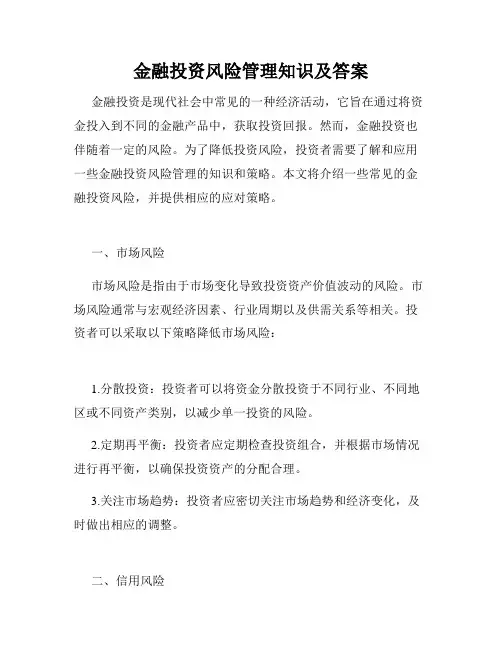
金融投资风险管理知识及答案金融投资是现代社会中常见的一种经济活动,它旨在通过将资金投入到不同的金融产品中,获取投资回报。
然而,金融投资也伴随着一定的风险。
为了降低投资风险,投资者需要了解和应用一些金融投资风险管理的知识和策略。
本文将介绍一些常见的金融投资风险,并提供相应的应对策略。
一、市场风险市场风险是指由于市场变化导致投资资产价值波动的风险。
市场风险通常与宏观经济因素、行业周期以及供需关系等相关。
投资者可以采取以下策略降低市场风险:1.分散投资:投资者可以将资金分散投资于不同行业、不同地区或不同资产类别,以减少单一投资的风险。
2.定期再平衡:投资者应定期检查投资组合,并根据市场情况进行再平衡,以确保投资资产的分配合理。
3.关注市场趋势:投资者应密切关注市场趋势和经济变化,及时做出相应的调整。
二、信用风险信用风险是指债务人无法按时或完全偿还借款本金和利息的风险。
投资者可以通过以下方式管理信用风险:1.评估债务人信用状况:在投资债券或信托产品时,投资者应评估债务人的信用状况,选择信用评级较高的债务人。
2.多元化债权组合:投资者可以将资金分散投资于多个债务人,降低单一债务人违约的风险。
3.及时回收欠款:如果投资者发现债务人出现违约情况,应及时采取法律手段追回欠款。
三、流动性风险流动性风险是指投资者在需要迅速变现资产或交易时,市场无法提供足够的买家或卖家,导致无法按照预期价格完成交易的风险。
投资者可以采取以下策略管理流动性风险:1.合理规划资金需求:投资者应合理规划资金需求,避免频繁买卖投资产品,以降低流动性风险。
2.选择流动性较好的资产:投资者可以选择流动性较好的金融产品,如交易所交易基金(ETF)等,以便在需要时迅速变现。
四、操作风险操作风险是指投资者由于自身操作不当或错误决策导致投资损失的风险。
投资者可以通过以下方式管理操作风险:1.确保充分准备:投资者应充分了解投资产品的特点和风险,做全面的调研和分析,避免盲目决策。
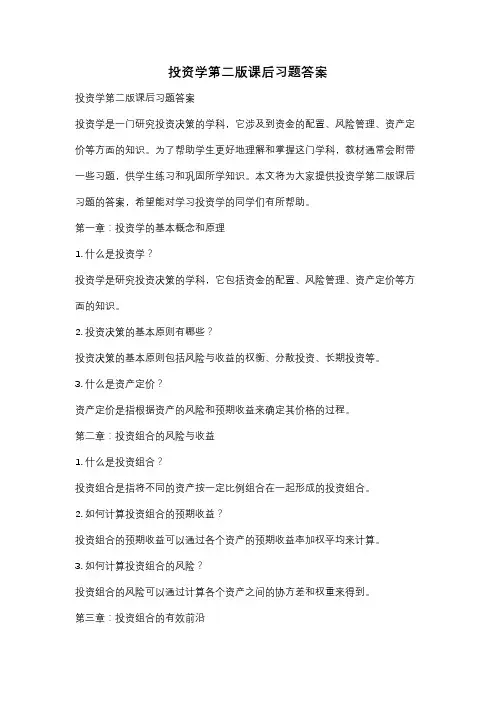
投资学第二版课后习题答案投资学第二版课后习题答案投资学是一门研究投资决策的学科,它涉及到资金的配置、风险管理、资产定价等方面的知识。
为了帮助学生更好地理解和掌握这门学科,教材通常会附带一些习题,供学生练习和巩固所学知识。
本文将为大家提供投资学第二版课后习题的答案,希望能对学习投资学的同学们有所帮助。
第一章:投资学的基本概念和原理1. 什么是投资学?投资学是研究投资决策的学科,它包括资金的配置、风险管理、资产定价等方面的知识。
2. 投资决策的基本原则有哪些?投资决策的基本原则包括风险与收益的权衡、分散投资、长期投资等。
3. 什么是资产定价?资产定价是指根据资产的风险和预期收益来确定其价格的过程。
第二章:投资组合的风险与收益1. 什么是投资组合?投资组合是指将不同的资产按一定比例组合在一起形成的投资组合。
2. 如何计算投资组合的预期收益?投资组合的预期收益可以通过各个资产的预期收益率加权平均来计算。
3. 如何计算投资组合的风险?投资组合的风险可以通过计算各个资产之间的协方差和权重来得到。
第三章:投资组合的有效前沿1. 什么是有效前沿?有效前沿是指在给定风险水平下,能够获得最大预期收益的投资组合。
2. 如何构建有效前沿?构建有效前沿需要计算各个资产的预期收益率、协方差矩阵,并通过优化模型来确定最佳的投资组合。
3. 有效前沿的作用是什么?有效前沿可以帮助投资者在风险和收益之间做出最优的选择,从而实现资产配置的最佳效果。
第四章:资本市场理论1. 什么是资本市场线?资本市场线是指在风险和收益之间形成的一条直线,表示投资组合的最佳效果。
2. 如何计算资本市场线?计算资本市场线需要确定无风险利率、市场组合的预期收益率和风险,以及投资组合的风险。
3. 资本市场线的作用是什么?资本市场线可以帮助投资者确定最佳的投资组合,从而实现资产配置的最佳效果。
第五章:投资者行为与市场效率1. 什么是投资者行为?投资者行为是指投资者在进行投资决策时所表现出的心理和行为特征。
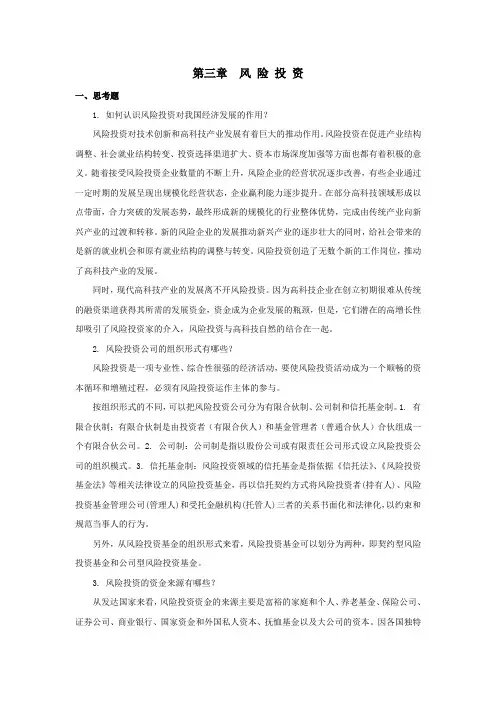
第三章风险投资一、思考题1. 如何认识风险投资对我国经济发展的作用?风险投资对技术创新和高科技产业发展有着巨大的推动作用。
风险投资在促进产业结构调整、社会就业结构转变、投资选择渠道扩大、资本市场深度加强等方面也都有着积极的意义。
随着接受风险投资企业数量的不断上升,风险企业的经营状况逐步改善,有些企业通过一定时期的发展呈现出规模化经营状态,企业赢利能力逐步提升。
在部分高科技领域形成以点带面,合力突破的发展态势,最终形成新的规模化的行业整体优势,完成由传统产业向新兴产业的过渡和转移。
新的风险企业的发展推动新兴产业的逐步壮大的同时,给社会带来的是新的就业机会和原有就业结构的调整与转变。
风险投资创造了无数个新的工作岗位,推动了高科技产业的发展。
同时,现代高科技产业的发展离不开风险投资。
因为高科技企业在创立初期很难从传统的融资渠道获得其所需的发展资金,资金成为企业发展的瓶颈,但是,它们潜在的高增长性却吸引了风险投资家的介入,风险投资与高科技自然的结合在一起。
2. 风险投资公司的组织形式有哪些?风险投资是一项专业性、综合性很强的经济活动,要使风险投资活动成为一个顺畅的资本循环和增殖过程,必须有风险投资运作主体的参与。
按组织形式的不同,可以把风险投资公司分为有限合伙制、公司制和信托基金制。
1. 有限合伙制:有限合伙制是由投资者(有限合伙人)和基金管理者(普通合伙人)合伙组成一个有限合伙公司。
2. 公司制:公司制是指以股份公司或有限责任公司形式设立风险投资公司的组织模式。
3. 信托基金制:风险投资领域的信托基金是指依据《信托法》、《风险投资基金法》等相关法律设立的风险投资基金,再以信托契约方式将风险投资者(持有人)、风险投资基金管理公司(管理人)和受托金融机构(托管人)三者的关系书面化和法律化,以约束和规范当事人的行为。
另外,从风险投资基金的组织形式来看,风险投资基金可以划分为两种,即契约型风险投资基金和公司型风险投资基金。

投资银行学课后思考题答案
1.投资银行的概念是什么?
投资银行是一种尤其专门从事财务咨询、评估、融资、金融产品设计
等职能的金融机构。
主要为政府机构、公司或个人提供资助,回报投
资银行的报酬可以是利润分享或由这些客户支付的费用。
2.投资银行如何为客户提供帮助?
投资银行为客户提供各种金融服务,帮助客户解决资金短缺、资金管
理等问题。
投资银行的核心业务主要包括像财务顾问、证券发行、咨
询服务等。
它们主要为企业客户提供财务支持、投融资服务、并购服务、企业基本金融服务、境外金融服务等。
此外,投资银行也为客户
提供资产管理、欧元债券等金融产品。
3.投资银行都有哪些内部和外部风险?
内部风险主要指投资银行活动所带来的风险,包括经营风险、财务风险、市场风险、信用风险等;外部风险是指投资银行外部环境本身造
成的风险,包括非金融环境的风险、宏观经济环境风险、政治环境风
险等。
4.投资银行的核心竞争力在哪里?
投资银行的核心竞争力在于其专业知识和工具、财务处理技能、国际
业务和市场知识、客户关系管理以及运用技术开展业务的能力等方面。
此外,投资银行的核心竞争力还取决于其能够监测金融服务提供者的行情发展趋势,给客户提供更成功的金融解决方案。
5.投资银行理财最重要的原则是什么?
投资银行理财的最重要原则是客观、科学和专业性。
客观性主要包括市场趋势,行业发展趋势,资产组合分配,以及资金投资选择等因素要被全面考虑;科学性方面,主要体现在风险与回报平衡,以及灵活把握原则性等地方;而专业性则指的是金融服务的周到性,为投资者提供一个公正、安全、可靠的理财环境,以及资金管理与资讯服务。
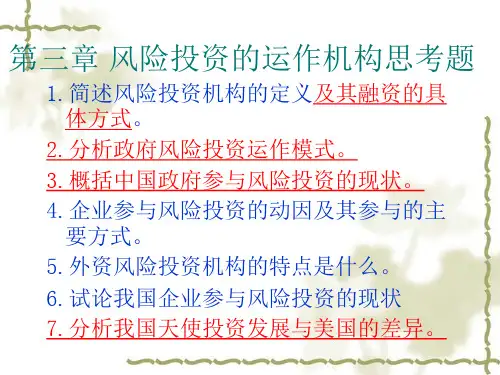
第一章选择题1-9ABADD CBAC 10 ABC 11ABD 12 ABCD13 ABCD 14 ACD 15 BD 16 AB 17BD思考题 1.投资就是投资主体、投资目的、投资方式和行为内在联系的统一,这充分体现了投资必然与所有权相联系的本质特征。
也就是说,投资是要素投入权、资产所有权、收益占有权的统一。
这是因为:①反映投资与所有权联系的三权统一的本质特征,适用于商品市场经济的一切时空。
从时间上看,无论是商品经济发展的低级阶段还是高度发达的市场经济阶段,投资都无一例外地是要素投入权、资产所有权、收益占有权的统一;从空间上看,无论是在中国还是外国乃至全球范围,投资都无一例外地是这三权的高度统一。
②反映投资与所有权联系的三权统一的本质特征,适用于任何投资种类和形式。
尽管投资的类型多种多样,投资的形式千差万别,但它们都是投资的三权统一。
③反映投资与所有权联系的三权统一本质特征贯穿于投资运动的全过程。
投资的全过程是从投入要素形成资产开始到投入生产,生产出成果,最后凭借对资产的所有权获取收益。
这一全过程实际上都是投资三权统一的实现过程。
④反映投资与所有权联系的三权统一本质特征,是投资区别于其他经济活动的根本标志。
投资的这种本质特征决定着投资的目的和动机,规定着投资的发展方向,决定着投资的运动规律。
这些都使投资与其他经济活动区别开来,从而构成独立的经济范畴和研究领域。
2.金融投资在整个社会经济中的作用来看,金融投资的功能具有共性,主要有以下几个方面:(1)筹资与投资的功能。
这是金融投资最基本的功能。
筹资是金融商品服务筹资主体的功能,投资是金融商品服务投资主体的功能。
社会经济发展的最终决定力量是其物质技术基础,物质技术基础的不断扩大、提高必须依靠实业投资。
(2)分散化与多元化功能。
金融投资促进了投资权力和投资风险分散化,同时又创造了多元化的投资主体集合。
金融投资把投资权力扩大到了整个社会。
(3)自我发展功能。
可编辑修改精选全文完整版第一章投资概述一、思考题1. 什么是投资?怎样全面、科学地理解投资的含义?投资是指经济主体为获取预期收益而投入各种经济要素,以形成资产的经济活动。
这一概念具有双重内涵,既是指为获得预期收益而投入的一定量资金及其他经济要素,也是指这种预期收益的实现过程。
依照学术界对投资范围的划分,可以把投资分为广义投资和狭义投资。
广义的投资是指以获利为目的的资金使用。
包括购买股票、债券和其他金融工具以及以获利为目的的特殊实物资产的买卖,也包括运用资金以建设厂房、购置设备和原材料等为目的从事与生产、销售有关的一系列活动,即包括金融投资和实业投资两大部分。
狭义的投资则是指购买各种有价证券,包括政府公债、公司股票、公司债券、金融债券、黄金外汇,以及以赚取增值差价为目的的房地产、字画、珠宝等实物投资等。
一般情况下,狭义的投资主要是指金融投资或证券投资。
投资必须具备的基本要素包括:投资主体、投资客体、投资目的和投资方式,这些要素缺一不可。
2.什么是实业投资和金融投资?按投资对象存在形式的不同,可以把投资分为实业投资与金融投资。
实业投资是指投资者将资金用于建造固定资产、购置流动资产、创造商誉与商标等无形资产,直接用于生产经营,并以此获得未来收益的投资行为,包括修建铁路、开采矿山、开办企业和更新设备等。
实业投资是典型的直接投资。
金融投资是指投资主体通过购买股票、债券,放贷和信托等方式将自己的资金委托或让渡给他人使用,自己收取一定的利息(股息)和红利的行为。
金融投资形成的资产是金融资产,并不涉及实际的产业经营,因此,金融投资是典型的间接投资。
3.实业投资环境与金融投资环境有何不同?投资环境是指投资活动的外部条件。
环境因素对投资主体的确定、投资决策、投资管理、投资风险和投资收益有着极大的影响,是投资者必须重视的内容。
环境因素包括一系列与投资有关的政治、经济、文化、自然、社会等方面的因素,这些因素相互独立但又相互影响、相互作用、相互制约,共同构成有机的整体。
第3章参考答案1.在投资领域中的风险是指金融资产价格波动给投资者收益率带来的不确定性,也就是说,风险的存在意味着尽管投资者一项投资(事后)的最终结果是唯一的,但在事前看来,由于各种影响因素的不确定性,投资者的投资可能会产生一个以上的结果。
一般来讲,金融领域关注的风险既包括损失发生的可能,也包括盈利发生的可能,而并不只是单纯考虑损失的情况。
投资风险具体来说,主要包括以下几方面内容。
(1)投资盈利和损失的概率,即盈利和损失各自发生的可能性。
(2)盈利和损失的程度,即盈利或损失发生后,各自的数量和幅度有多大。
(3)盈利和损失的易变形性,即在盈利和损失的范围内各自的易变程度。
2.金融市场上风险者面临的风险有多种分类方法,按风险来源可分为市场风险、通货膨胀风险、利率风险、汇率风险、信用风险、流动性风险、经营风险和政治风险;按能否分散可以分为系统性风险和非系统性风险。
3.在金融市场中,投资者对待风险的态度可以分为三类:风险厌恶型、风险中性型和风险偏好型。
风险厌恶型的投资者在面对相同的预期收益时,总是偏好风险较小的进行交易。
对于这类投资者来说,如果想使之接受交易中的风险,就必须在价格上给予足够的补偿,有风险交易的收益从结构上看应该是无风险交易的收益加上一个风险补偿额,而且风险补偿额与风险成正比。
风险中性型投资者并不关心风险的高低,他们只根据预期收益率的高低来进行决策,这意味着对这种投资者来说,风险并不是影响决策的障碍。
风险中性的投资者对自己承担的风险不要求风险补偿。
此类型的投资者投资决策的原则是:当预期收益相同时,他们偏好风险更大的资产,因为这会给他们带来更大的效用。
不同风险态度的效用函数如图:UCX) U(X)对于风险厌恶者,随着收益的增加效用提高,但效用提高的程度呈递减趋势。
风险厌恶者的效用函数是凹函数,即期望的效用大于效用的期望,表示为U[E(X)]〉E[U(X)]。
对于风险中性者,收益增加为投资者带来的边际效用是一个常数,因此,这种类型投资者的效用函数是线性的,即期望的效用等于效用的期望,表示为U[E(X)] = E[U(X)]。
张金清金融风险管理思考题
(原创实用版)
目录
1.张金清金融风险管理的背景和意义
2.金融风险的分类和评估方法
3.金融风险管理的策略和工具
4.张金清金融风险管理的思考题解析
正文
张金清金融风险管理是我国金融领域的一项重要研究课题,它的提出源于金融市场的日益复杂化和风险的加剧。
金融风险是指在金融市场上,由于各种不确定因素的影响,导致金融资产和金融交易的价值受到损失的可能性。
金融风险管理的目的是通过科学的方法和手段,对金融市场上的风险进行识别、评估、控制和监测,以保障金融市场的稳定和金融资产的安全。
金融风险的分类主要有信用风险、市场风险、操作风险和流动性风险等。
信用风险是指由于借款人或者交易对手的违约导致的风险;市场风险是指由于市场价格波动导致的风险;操作风险是指由于内部管理不善或者人为错误导致的风险;流动性风险是指由于资产不能及时变现导致的风险。
金融风险的评估方法主要有风险价值法、极限测试法、敏感性分析法和情景模拟法等。
风险价值法是通过计算可能的最大损失来评估风险;极限测试法是通过模拟极端市场情况来评估风险;敏感性分析法是通过改变某个变量来评估风险;情景模拟法是通过模拟不同的市场情景来评估风险。
金融风险管理的策略主要有风险分散、风险对冲、风险转移和风险规避等。
风险分散是通过将资金投资到不同的资产或者市场上来降低风险;风险对冲是通过金融工具对冲金融风险;风险转移是通过金融工具将风险转移给其他方;风险规避是通过避免或者退出高风险的市场或者资产来规
避风险。
张金清金融风险管理的思考题主要包括:如何识别和评估金融风险?如何制定和实施金融风险管理策略?如何监测和控制金融风险?。
P45第一章习题答案1.答:交易机制指市场的交易规则和保证规则实施的技术以及规则和技术对定价机制的影响。
它的主要研究内容包括:从市场微观结构的角度去看,价格是在什么样的规则和程序中形成的,并分析交易机制对资产交易的过程和结果的影响。
2.答:报价驱动机制与指令驱动机制的区别在于:①价格形成方式不同。
在采用做市商制度的市场上,证券的开盘价格和随后的交易价格是由做市商报出的,而指令驱动制度的开盘价与随后的交易价格都是竞价形成的。
前者从交易系统外部输入价格,后者的成交价格是在交易系统内部生成的。
②信息传递范围与速度不同。
采用做市商机制,投资者买卖指令首先报给做市商,做市商是唯一全面及时知晓买卖信息的交易商,成交量与成交价随后才会传递给整个市场。
在指令驱动机制中,买卖指令、成交量与成交价几乎同步传递给整个市场。
③交易量与价格维护机制不同。
在报价驱动机制中,做市商有义务维护交易量与交易价格。
而指令驱动机制则不存在交易量与交易价格的维护机制。
④处理大额买卖指令的能力不同。
做市商报价驱动机制能够有效处理大额买卖指令。
而在指令驱动机制中,大额买卖指令要等待交易对手的买卖盘,完成交易常常要等待较长时间。
其它交易机制还包括混合交易机制、特殊会员制度等。
3.答:一般来说,做市商市场的流动性要高于竞价市场,即投资者在竞价市场所面临的执行风险要大于做市商市场。
但是,竞价市场的透明度要好于做市商市场,同时,做市商市场的平均交易成本要高于竞价市场。
竞价市场的优点:①透明度高。
在指令驱动制度中,买卖盘信息、成交量与成交价格信息等及时对整个市场发布,投资者几乎可以同步了解到交易信息。
透明度高,有利于投资者观察市场。
②信息传递速度快、范围广。
指令驱动制度几乎可以实现交易信息同步传递,整个市场可以同时分享交易信息,很难发生交易信息垄断。
③运行费用较低。
投资者买卖指令竞价成交,交易价格在系统内部生成,系统本身表现出自运行特征。
这种指令驱动系统,在处理大量小额交易指令方面,优越性较明显。